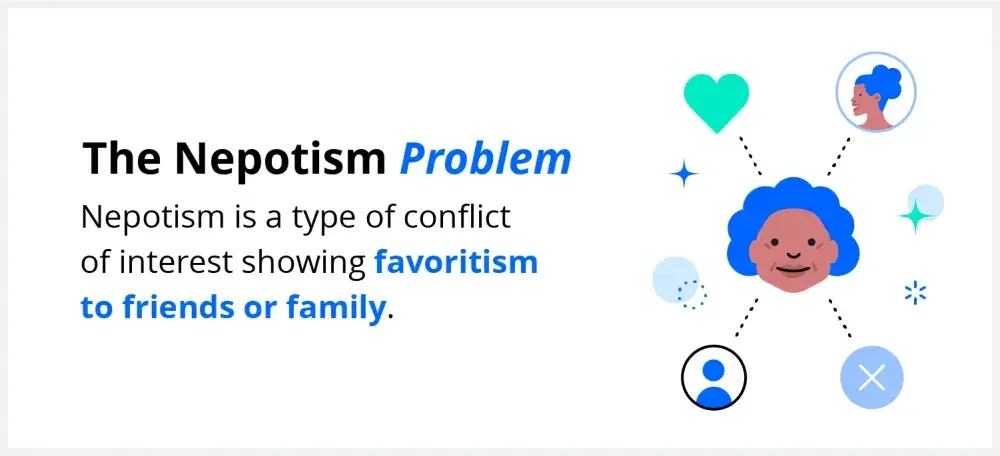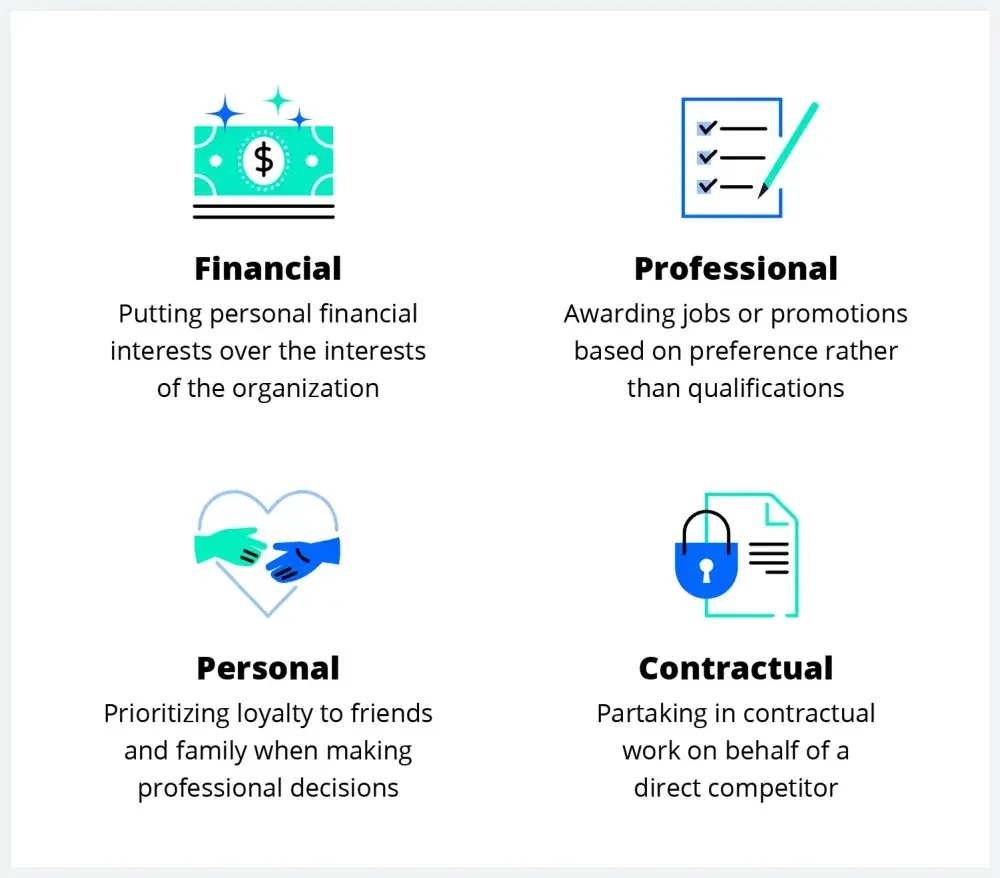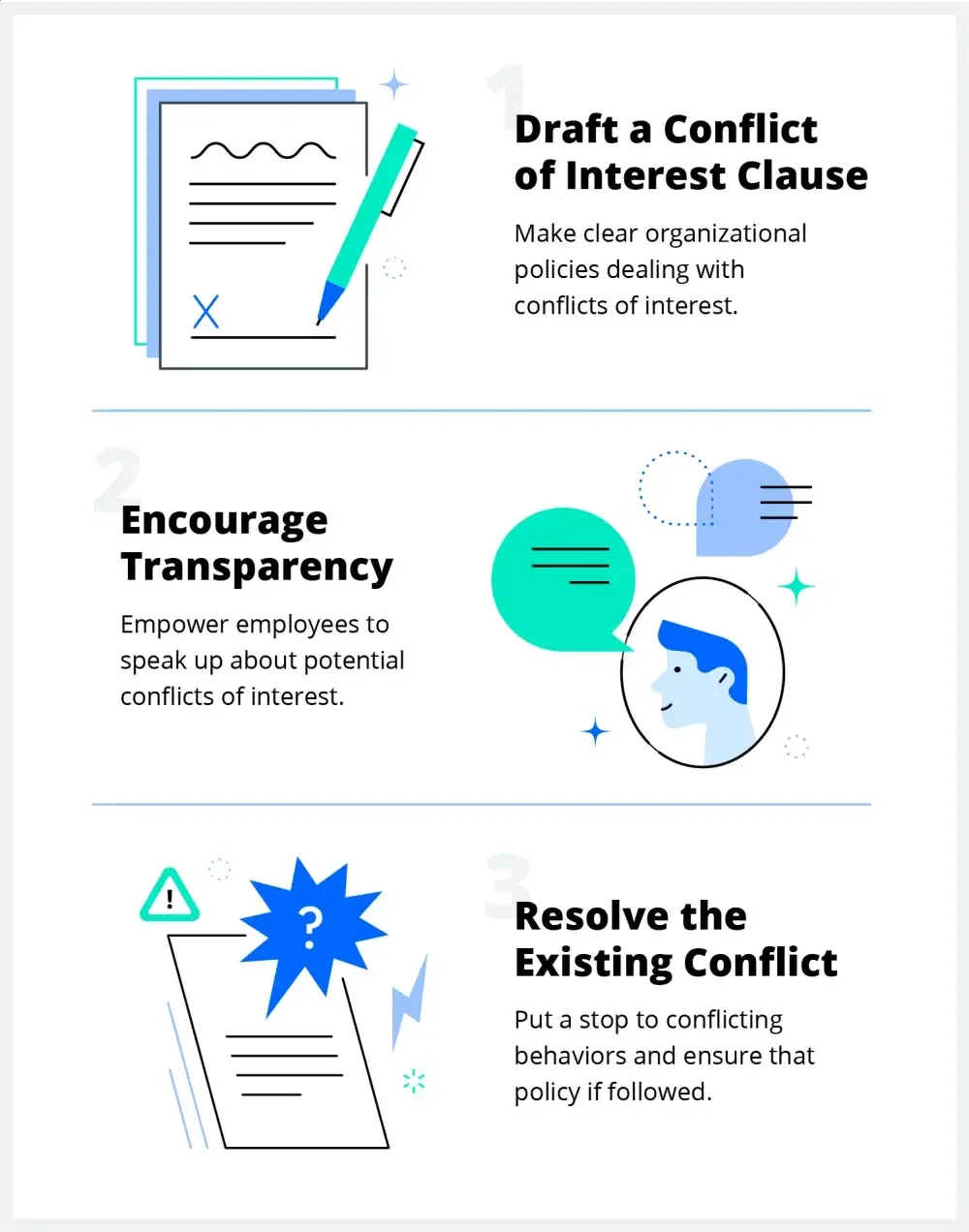All employees have their own lives and relationships outside of work, and sometimes those interests run counter to the best interests of their employers. But what constitutes a conflict of interest can be ambiguous.
To help you better understand how to spot a conflict and protect your brand by preventing them, dive into this guide.

What is a conflict of interest?
A conflict of interest is any kind of friction that could impede an individual's interests or judgment in the workplace. This friction is the result of overlapping interests that compete for one person's time and attention.

There are many ways conflicts of interest can manifest in the workplace. Nepotism bias, for example, can lead us to show a preference for relationships with people we are familiar with, leading to conflict if we grant those people any kind of special treatment. Sometimes, even a potential conflict of interest can become a real one.
Is a conflict of interest illegal?
It can be. There are multiple federal and state laws that criminalize and prosecute conflicts of interest. Even if a conflict of interest is not illegal, it is likely to lead to suspension or job loss when discovered.
To spot conflicts of interest when they arise (or snuff them out before they happen), it's best to familiarize yourself with the different types of conflicts of interest.
4 types of conflicts of interest

Conflicts of interest exist in many forms in the workplace. Generally, conflicts can be broken into one of four categories of interests:
- Financial Interests: Putting personal financial interests over the interests of the organization
- Professional Interests: Awarding jobs, promotions, or more based on preference rather than qualifications
- Personal Interests: Prioritizing loyalty to friends and family when making professional decisions, called nepotism
- Contractual Interests: Partaking in contractual work on behalf of a direct competitor
As you can imagine, these types of conflicts of interest can intersect. It's possible to partake in contractual work on behalf of a direct competitor that's also owned by your sister—a conflict of personal and contractual interests.
Therefore, dealing with conflicts of interest becomes a matter of prevention rather than reaction: If you create a plan to deal with potential conflicts, you might be more likely to avoid them in the first place.
3 best practices to deal with conflicts of interest at work

Dealing with conflicts of interest in the workplace can be tricky. With multiple parties involved, the difference between a clear “right" and “wrong" path forward may not be so obvious. Make sure you consider the following best practices before you have to deal with a conflict of interest at work.
1. Have a clear conflict of interest policy
A clear policy or conflict of interest clause that defines the organization's directives around conflicts is essential to avoiding, preventing, and dealing with these conflicts when they arise. Common policy inclusions to combat conflicts of interest include:
- Gift issuance clauses to prevent employees from accepting one-off gifts from clients or vendors
- Insider trading guards prevent confidential information from being used in a way that benefits an employee. Companies often have separate policies around insider trading.
- Confidentially provisions to help prevent employees from taking confidential information to competitors. You may also want to talk to an attorney about whether or not to include a noncompete clause.
2. Encourage open and honest communication
When employees find themselves in the midst of a potential conflict of interest, it's important that they feel empowered to disclose that information. You might encourage employees to:
- Disclose conflicting personal relationships immediately to human resources
- Speak with a manager about how to avoid potential conflicts of interest
- Participate in annual training designed to help spot conflicts when they arise
Disclosure doesn't always guarantee smooth sailing, but transparency around a potential conflict is more likely to instill trust with colleagues who are tasked with handling the conflict.
3. Resolve the existing conflict
If a conflict of interest can't be prevented or avoided, it needs to be dealt with directly. Your conflict of interest clause or policy should clearly state any steps for you to take. Some common mitigation tactics, depending on the severity of the conflict, are to:
- Speak with a lawyer about the legal ramifications of the conflict
- Warn the employee in writing about repeating the behavior
- Remove the employee from the internal project that causes conflict
Of course, the conflict may necessitate stronger action. Make sure you know all there is to know about the conflict before making your decision.
11 examples and practical applications for business owners
One of the best ways to spot conflicts of interest and prepare to handle them is by familiarizing yourself with examples of common conflicts. We've detailed examples below that involve nepotism, professional interests, and self-dealing as driving factors.
1. Nepotism
A hiring manager interviews and hires their college roommate for a sales position. The new hire is unfamiliar with the industry, and the hiring manager chose the roommate over other candidates that were more highly qualified.
2. Professional interest
A system administrator for a cybersecurity company offers consulting services to a competing organization, sharing confidential intellectual property in the process. These services help the competing organization develop a rival product that takes market share from the system administrator's employer.
3. Self-dealing
A procurement manager awards a new labor contract to an organization they own stock in. The contract is much larger than any recent job the organization has taken on, indicating that they may not have the best experience for the job.
More examples of conflicts of interest
Here are more examples of potential and actual conflicts of interest.
- Starting a company that offers related services to those of your full-time job
- Offering confidential information in exchange for payment from a competitor
- Refusing to discipline a colleague because of a preexisting relationship
- Having a romantic relationship with a subordinate or supervisor
- Disclosing information protected by nondisclosure agreements
It's best to ask first if you suspect a potential conflict is developing. Hopefully, the threat of potential conflicts of interest will encourage transparency and honesty that make the workplace a more positive, collaborative environment for everyone.
Care to view this information in an infographic? View our conflict of interest guide here.

